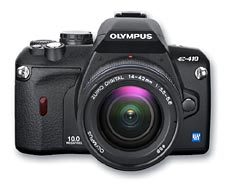The 10-megapixel Olympus E-410 updates the E-400 with a new Live MOS image sensor, and new TruePic III image processor.
Olympus E-410 Review
Design
Small & Light
Just as the E-410 shares much of its inner workings with the E-400, so it shares the same design principle, and indeed camera body. ‘Small and light’ is the order of the day, with the lack of a right hand finger grip and its streamlined design giving it the look and feel of the Olympus OM System 35mm film SLRs of two decades ago. However, where the OM cameras relied on metal for their construction, the E-410 uses ‘glass reinforced plastics’, with rubber finger and thumb pads for added grip. The end result is a DSLR body that weighs in at a mere 375g without a lens and certainly doesn’t take up much space within a camera bag. It’s a shame that Olympus didn’t take the opportunity to move the right hand strap lug though; as with the E-400, it sits exactly where your middle finger wants to rest, compromising an otherwise comfortable grip on the camera.
Control Layout
While the E-410’s one of the most ‘traditional’ looking DSLRs on the market in terms of scale and shape, this certainly doesn’t extend to the controls. The top-plate looks decidedly busy, with a host of buttons, dials and switches, although much of its cluttered appearance is due to the large printed icons that describe the various buttons’ many functions.
By comparison, the back of the camera is decidedly neat, with four buttons to the left of the LCD used to review and delete images, as well as to call up the menu and on-screen information. The right is occupied by the focus/exposure lock, a button to activate the live view mode (more on that later), and a four-way toggle switch.
Menu Navigation
Within the four-way switch is the ‘ok’ button, which is obviously used to ok settings in the menu, but when you’re in ‘shooting mode’ it also turns the information displayed on the rear LCD screen ‘live’. Like the E-400 you can then scroll around the various settings (ISO, white balance, image quality etc) and a second press of the ok button takes you straight to the relevant adjustment page of the menu. Some might argue there are too many button pushes involved if you want to change more than one thing at a time, but we still believe this is the most comprehensive and easily mastered ‘short-cut’ system used by any manufacturer. Much of this information – especially when changes have been made – is also relayed through the E-410’s viewfinder, where it’s picked out in green to the right of the focusing screen. The information is bright enough to remain legible in all but the brightest conditions, but as with most Four Thirds cameras, the viewfinder doesn’t provide the greatest view of the scene. The 95% coverage is what we’d expect, and is reasonably bright, but the small sensor found in a Four Thirds camera results in a slightly small viewfinder, which is a shame. We’d prefer a larger, and therefore clearer view.





